

Map of the world in the Hellenistic Age. Greek Warships. Greek trireme (Lenormant relief, ca. 410 BC, now in Athens Acropolis Museum) People called the earliest Greek warships pentekontors.
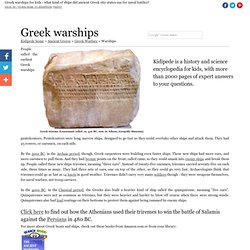
Pentekontors were long, narrow ships, designed to go fast so they could overtake other ships and attack them. Ancient Greek Warfare for Kids! Trojan Horse. Earliest picture of the Trojan Horse, on a vase ca. 670 BC After the events of the Iliad and the death of Hector, the Trojan War still wasn't over.

Neither the Greeks nor the Trojans seemed to be able to win, until one of the Greek kings, Odysseus of Ithaca, had an idea. "Build a big wooden horse on wheels," he said, "big enough for a bunch of Greek soldiers to hide inside it. " So the Greeks did. Then the Greeks all pretended to sail home (except the ones hiding inside the horse!). Soon the Trojans found the horse. Peristyle - Greek Architecture for Kids! Greek Astronomy. Archimedes - Greek Science for Kids! Olympic Athletic Competition - Ancient Greece for Kids.
Greek Wrestlers At first, the only athletic competition at the Olympics was a single short foot race, 170 meters long.
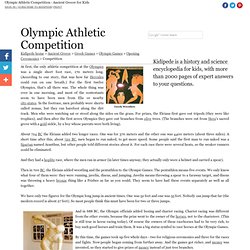
(According to one story, that was how far Hercules could run on one breath.) For the first twelve Olympics, that's all there was. The whole thing was over in one morning, and most of the contestants seem to have been men from Elis or nearby city-states. Ancient Greek Clothing. Greek babies often wore nothing at all, but sometimes, as in this picture, they wore cloth diapers.
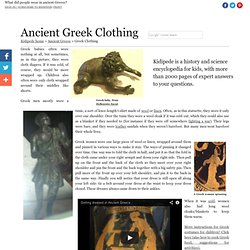
If it was cold, of course, they would be more wrapped up. Children also often wore only cloth wrapped around their middles like shorts. Greek men mostly wore a tunic, a sort of knee-length t-shirt made of wool or linen. Often, as in this statuette, they wore it only over one shoulder. Over the tunic they wore a wool cloak if it was cold out, which they could also use as a blanket if they needed to (for instance if they were off somewhere fighting a war). A Greek woman spinning Greek women wore one large piece of wool or linen, wrapped around them and pinned in various ways to make it stay. When it was cold, women also had long wool cloaks/blankets to keep them warm. Greek Schools - Ancient Greece for Kids. A Greek school: the teacher is sitting in the chair.
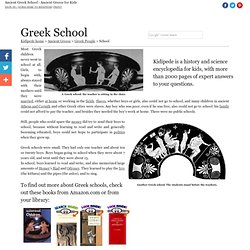
Most Greek children never went to school at all. Girls, to begin with, always stayed with their mothers until they were married, either at home or working in the fields. Slaves, whether boys or girls, also could not go to school, and many children in ancient Athens and Corinth and other Greek cities were slaves. Any boy who was poor, even if he was free, also could not go to school: his family could not afford to pay the teacher, and besides they needed the boy's work at home. There were no public schools. Another Greek school. Still, people who could spare the money did try to send their boys to school, because without learning to read and write and generally becoming educated, boys could not hope to participate in politics when they grew up. Greek schools were small. To find out more about Greek schools, check out these books from Amazon.com or from your library:
City-States for Kids! A city-state (what the Greeks called a polis, which is where our word politics comes from) is like a very small country, with just one city in it.
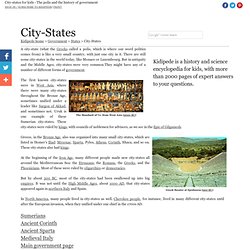
There are still some city-states in the world today, like Monaco or Luxembourg. But in antiquity and the Middle Ages, city-states were very common.They might have any of a number of different forms of government. The Standard of Ur, from West Asia (2000 BC) The first known city-states were in West Asia, where there were many city-states throughout the Bronze Age, sometimes unified under a leader like Sargon of Akkad, and sometimes not. Uruk is one example of these Sumerian city-states. Greek theater at Epidauros (200 BC) Hellenistic Period Greece. Alexander fighting Darius, the Persian king (mosaic from Pompeii) After the Peloponnesian War was over, all the cities of Greece were worn out and poor.

Many men went and fought for the Persians for money. But others tried to rebuild the cities. This was the time of Socrates and his student Plato, the great philosophers. Philip of Macedon (on a coin) But to the north of Greece, in a country called Macedon (MA-suh-donn), King Philip had noticed that the Greeks were very weak. Alexander was a great general, and the Persians were also weak at this time. Alexander died without any sons old enough to rule, and so his kingdom was split up among his generals. More about Alexander the Great Greece under Roman rule To find out more about Hellenistic Greece, check out these books from Amazon.com or from your local library: Oxford First Ancient History, by Roy Burrell and Peter Connolly (1997). Classical Greece. Ancient Democracy - Government for Kids!